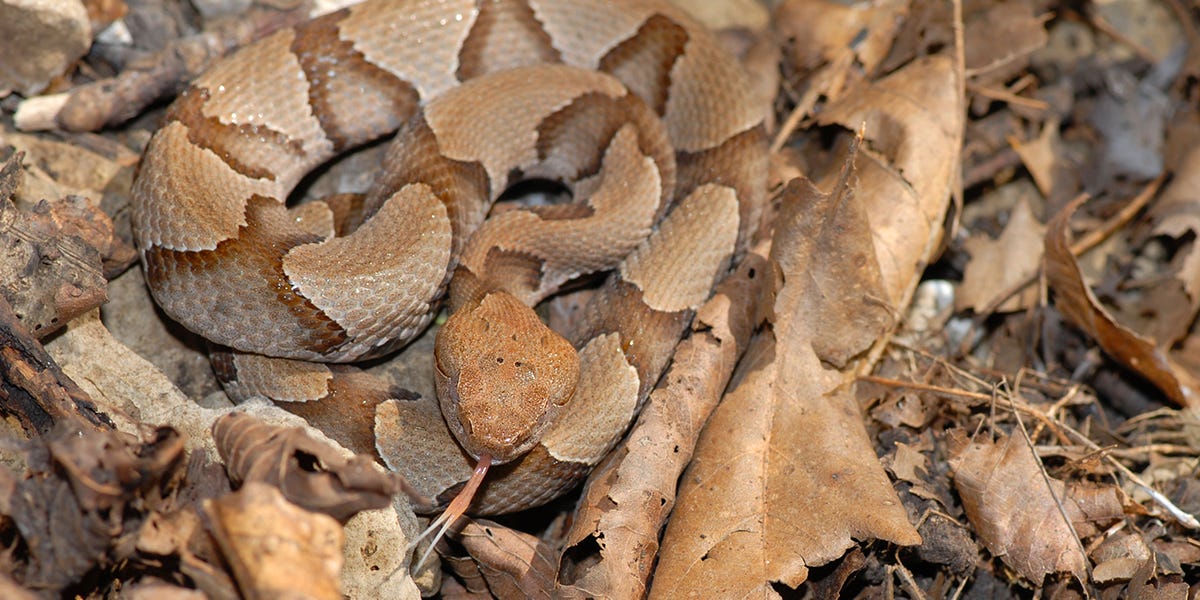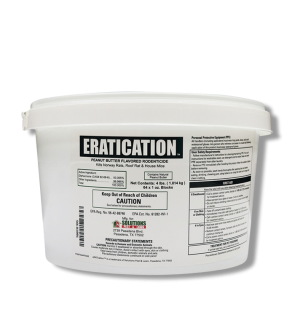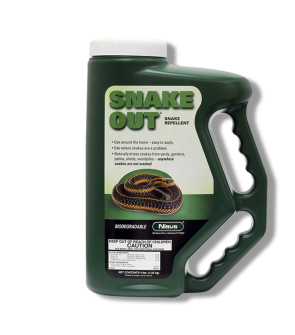Gain access to personalized product screening, the best pricing, rewards, and more!
Most Effective Products
How to Get Rid of Copperhead Snakes
This page is an expert guide on getting rid of copperhead snakes from your yard using the products and methods suggested by our experienced pest control specialists. Follow this guide and use the recommended products, and you will eliminate copperhead snake activity around your yard.
It can be startling to find a snake in your yard, especially if it's a larger snake like the copperhead snake. Copperhead snakes are one of the most commonly found snakes in North America, particularly around the Eastern coast and the mid-Southern states.
Copperhead snakes are venomous and deliver a very painful bite if you come close, so finding one in your backyard can be dangerous, especially if you have small children. If you have encountered a copperhead snake in your yard or live in an area where they are common, read on to learn how you can ward off this snake from your property.
Identification

It's important to first properly identify whether or not you are encountering a Copperhead Snake before moving forward with a treatment program. Misidentification can lead to using the wrong treatment methods, which can waste time and money. Copperhead snakes are a can't-miss type of creature; you'll know when you have seen them because they are so distinctive. Here are some traits to watch out for to properly identify copperhead snakes:
- Copperhead snakes range between 24 to 40 inches long and have triangular heads. They are usually light brown or tan in color and have dark, irregular bands patterned along their bodies. This coloring helps the snake camouflage itself and blend into its surroundings. They get their name from their often copper-colored heads.
- Copperhead Snakes are carnivores and prey on rodents such as mice and rats, but they also prey on small birds, frogs, and small insects.
- Copperhead Snakes have a venomous bite, but their bites rarely cause fatalities. This is because they inject very little poison when they bite a human compared to when they bite one of their prey. They are not aggressive and merely deliver warning bites when they feel threatened.
Use the image and description above to help you to identify copperhead snakes you find on your property. If you are unsure, contact us; one of our pros will assist you with identification.
Inspection
After you have confirmed that you are dealing with copperhead snakes, you need to proceed with an inspection. During this phase, you will need to locate the areas where the copperhead snake is frequenting so you know what areas to treat.
Where to Inspect
Copperhead snakes thrive in a variety of habitats, but they mostly prefer woody areas and tall grass for cover. You can also find them in garden areas or along the exterior walls of a home. Check areas of your yard with a lot of wood, mulch, and leaf litter.
What To Look For
Scan around the exterior perimeter of your home and your yard to find the copperhead snake itself. If there is the presence of more than one copperhead snake, then it's likely that your yard is a favorable environment to them with plenty of hiding spots and food sources, like rodents.
Treatment
To control snake activity around your yard, you will need to address the conducive conditions that are attracting the copperhead snake to your yard. This includes clearing up leaf litter and removing any food sources.
If you encounter a snake, we highly advise you not to try to kill it, as you may risk getting bitten. For snakes you know are present, you can deter them from your yard with a snake repellent like Snake Out.
Step 1: Remove Food Sources
If you have found a copperhead snake in your yard and garden, then it is safe to assume that there is a food source nearby, which is exactly why the snake is so comfortable on your property. It is imperative that every homeowner first addresses any food source that the snake is living on.
Snakes prey on small rodents, birds, insects, and lizards, so first remove all of these food sources to help you get control of Copperhead snakes.
For rodent control, use Eratication, a powerful rodenticide bait shaped into blocks, along with The Solutions tamper-proof Rodent Bait Stations. Eratication is a multi-feed bait used to control rats and mice. We use tamper-proof bait stations to keep the bait safely out of the reach of children and pets and protected from the elements. Our bait stations are made with a tamper-proof lid that requires a key included with each station to open.
When handling bait and stations, it is important to wear gloves. This will protect you from the bait and keep your scent off the stations, which will often deter rodents from the bait. Place three Eratication bait blocks into your station. Each bait block has a pre-drilled hole, allowing you to easily slide it onto the supplied metal rods in the bait station's interior.
Place your rodent bait stations along perimeter walls or fencerows. These are areas where rats and mice typically travel. Place each station about 10 to 15 feet apart to ensure thorough coverage of your area. Check the stations frequently to see if there is any rodent activity.
Step 2: Apply Supreme IT Insecticide
For insects that copperhead snakes prey upon, apply Supreme IT. Supreme IT is a broad-spectrum insecticide that is labeled for treating over 70 different labeled insect pests. It also has a long residual effect that kills for up to 90 days after application.
To apply Supreme IT, mix with water in a handheld pump or hose-end sprayer.
Apply Supreme IT at 1 oz per gallon of water to cover 1,000 sq. ft.
Use volumes of up to 10 gallons per 1,000 sq. ft. to accomplish uniform control when applying to dense grass foliage.
Measure the square footage of your lawn to determine how much Supreme IT you need to cover the entire area. Shake well and pump your sprayer.
Broadcast the Supreme IT mixture and spray your yard and garden instead of spot-treating. Use a fan spray setting to get nice uniform coverage.
Next, you should spray a perimeter treatment of Supreme around the outside of your home and structure to create a barrier that will keep beetles out. Spray around doors and windows, around the foundation going up 2 or 3 feet, and then spray any other possible entry points.
Step 3: Use Snake Out Snake Repellent
Once you have removed all the food sources near your home and garden, the next step is to invest in a snake repellant like Snake Out. Snake Out will not kill the snake but actually aggravate it with its special blend of natural ingredients, disturbing the snake's sense of smell to the extent that the snake will relocate to a new destination.
First, determine the size of your yard by measuring and multiplying the length by the width. Applying Snake Out 8 inches wide by 50 feet in length or 1 lb per 100 sq. ft is recommended.
Once you calculate the square footage, lightly sprinkle a band 6 to 8 inches wide around, into, or next to the area you wish to protect. You can also apply it to voids, holes, and cracks around your home and in your garage, sheds, and other areas where you suspect they may travel.
Prevention
Prevention is the best cure, especially when it comes to a copperhead snake infestation. Consider the following preventative measures to ensure you don't experience a snake slithering onto your property again.
- Seal up all of the food in your home.
- Consider removing all of the other pests in your home.
- Trim your garden and mow your grass regularly.
- Cover all your home's entry points with caulk and Stuf-Fit Copper Mesh.
Key Takeaways
What are Copperhead Snakes?
- Copperhead snakes in your yard can be a dangerous threat and could be a sign that you have a rodent or heavy insect problem that needs to be addressed.
How To Get Rid of Copperhead Snakes
- Reduce the insect population with a broadcast and barrier treatment of Supreme IT.
- If you are aware of a rodent issue, lay out traps and rodenticide baits to kill rats and/or mice and remove the snake's food supply.
- Use a snake repellent such as Snake Out around your yard and perimeter to ward off copperhead snakes and deter them from the area.
Preventing Copperhead Snakes From Returning
- Prevent copperhead snakes from coming back to your property by reducing yard debris and addressing continued rodent and pest issues. You also need to seal entry points into the home with caulk and copper mesh.














